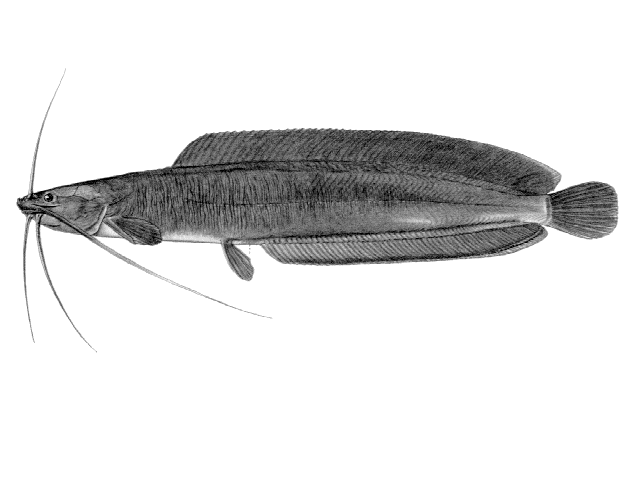| Clariidae (Airbreathing catfishes) |
| 34.1 cm TL (male/unsexed) |
|
demersal; freshwater; pH range: 6 - 7.5; dH range: 15 - 25, potamodromous |
| Africa: from coastal rivers of Benin and Nigeria over rivers Cross, Sanaga, Wouri and Ogooué (Cameroon and Gabon) to the Congo River basin (Democratic Republic of the Congo, Angola, Congo Republic, Central African Republic and Zambia) (Ref. 248). |
|
Dorsal spines (total): 0-0; Dorsal soft rays (total): 75-88; Anal spines: -0; Anal soft rays: 55-68; Vertebrae: 56-63. Diagnosis: head relatively broad, 14.2-20.9% of standard length (Ref. 57129, 81644). Head length 21.0-27.9% SL (Ref. 101841). Wide interorbital distance (Ref. 248), 41.3-51.8% averaging 46.4% of head length (Ref. 57129, 81644). Large tooth plates (Ref. 248), width of premaxillary tooth plate 25.9-37.2% of head length (m=29.5), width of vomerine tooth plate 21.0-31.2% of head length (Ref. 57129, 81644). Barbels extremely long (Ref. 248, 57129, 81644), nasal barbel 77.8-187.5%, maxillary barbel 142.9-305.8%, inner mandibular barbell 58.9-128.7%, and outer mandibular barbell 104.3-211.2% of head length (Ref. 57129, 81644). Head rather rectangular in dorsal outline; eyes more laterally located (Ref. 248). Frontal fontanelle long and narrow ("knife-shaped")(Ref. 248, 57129). Occipital fontanelle oval-shaped; pectoral spine robust and slightly curved (Ref. 248), strongly serrated on outside and inside (Ref. 81644, 101841). Gill rakers on first branchial arch long and slender; suprabranchial organ well developed, however not completely filling the cavity (Ref. 248). Openings of secondary canals of lateral line irregularly placed on the body (Ref. 248, 81644). Cleithrum mostly embedded in soft tissue, only thin bony ridge is exposed through skin; dorsal fin length 61.5-73.0% SL; distance from dorsal to caudal fin -1.4-2.1% SL (Ref. 101841).
Colouration: both live and preserved specimens usually dark-coloured (Ref. 57129, 81644, 101841). 2 types of colouration: one uniform dark brown to black on back and sides and light on belly (Ref. 57129, 81644, 101841), and upper sides of paired fins dark on lower sides and light on upper sides (Ref. 248). The other marbled, with small brown spots against a light background on back and sides and belly whitish; very dark unpaired fins; caudal fin with a series of vertical bars (a light bar in the middle flanked by dark ones)(Ref. 248, 57129, 81644, 101841). Some specimens may show irregular pattern of small white spots on body (Ref. 101841). |
| Found in lakes, rivers, floodplains and swamps. Bottom feeder, the stomach contained plants, algae, insect larvae (Ephemeroptera, Chironomidae, Ceratopogonidae, Odonata), Entomostraca (Cladocera, Ostracoda), Thecamiba and remains of insects (Ref. 248). |
|
Least Concern (LC); Date assessed: 28 April 2019 Ref. (130435)
|
| harmless |
Source and more info: www.fishbase.org. For personal, classroom, and other internal use only. Not for publication.

